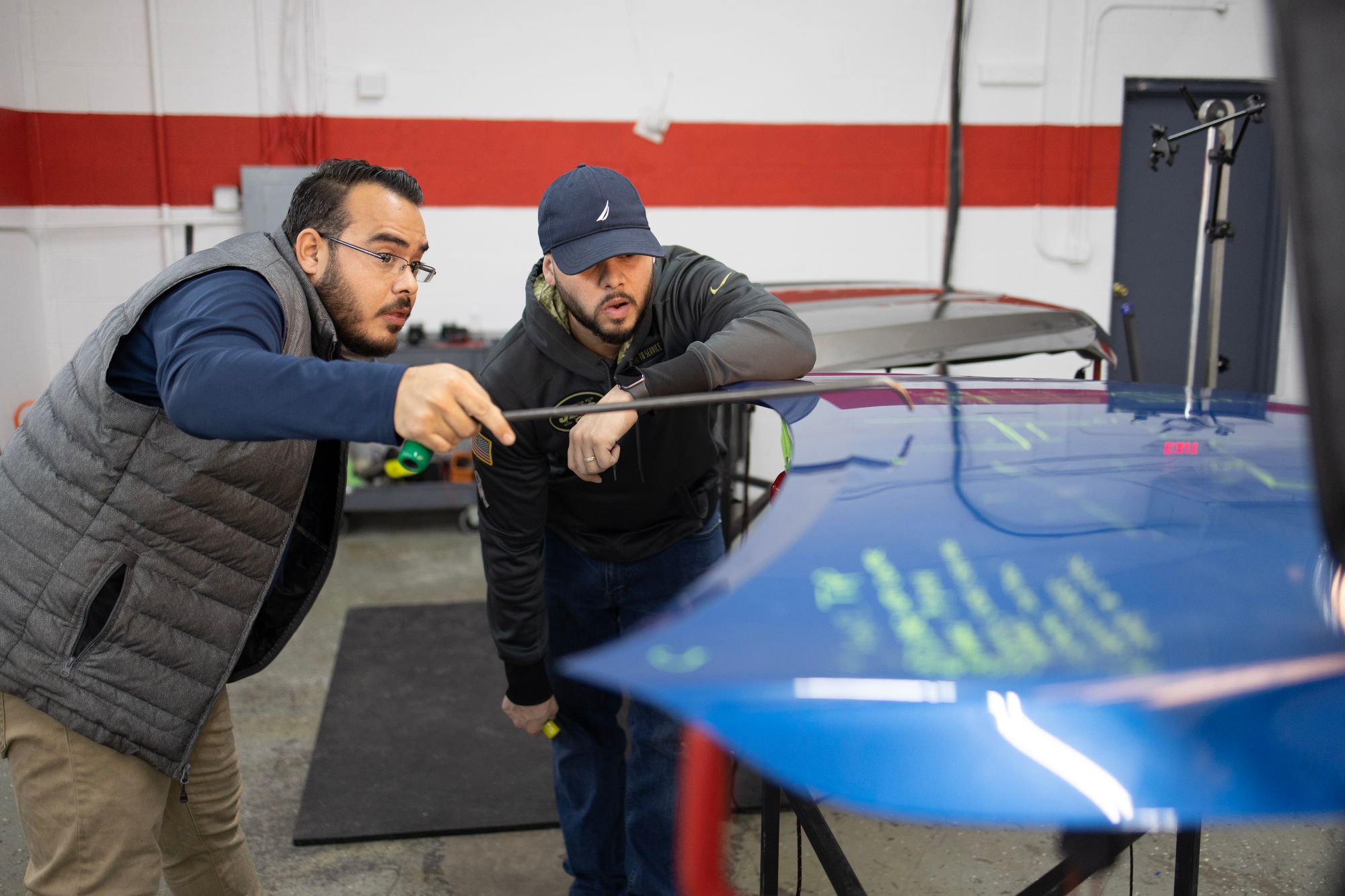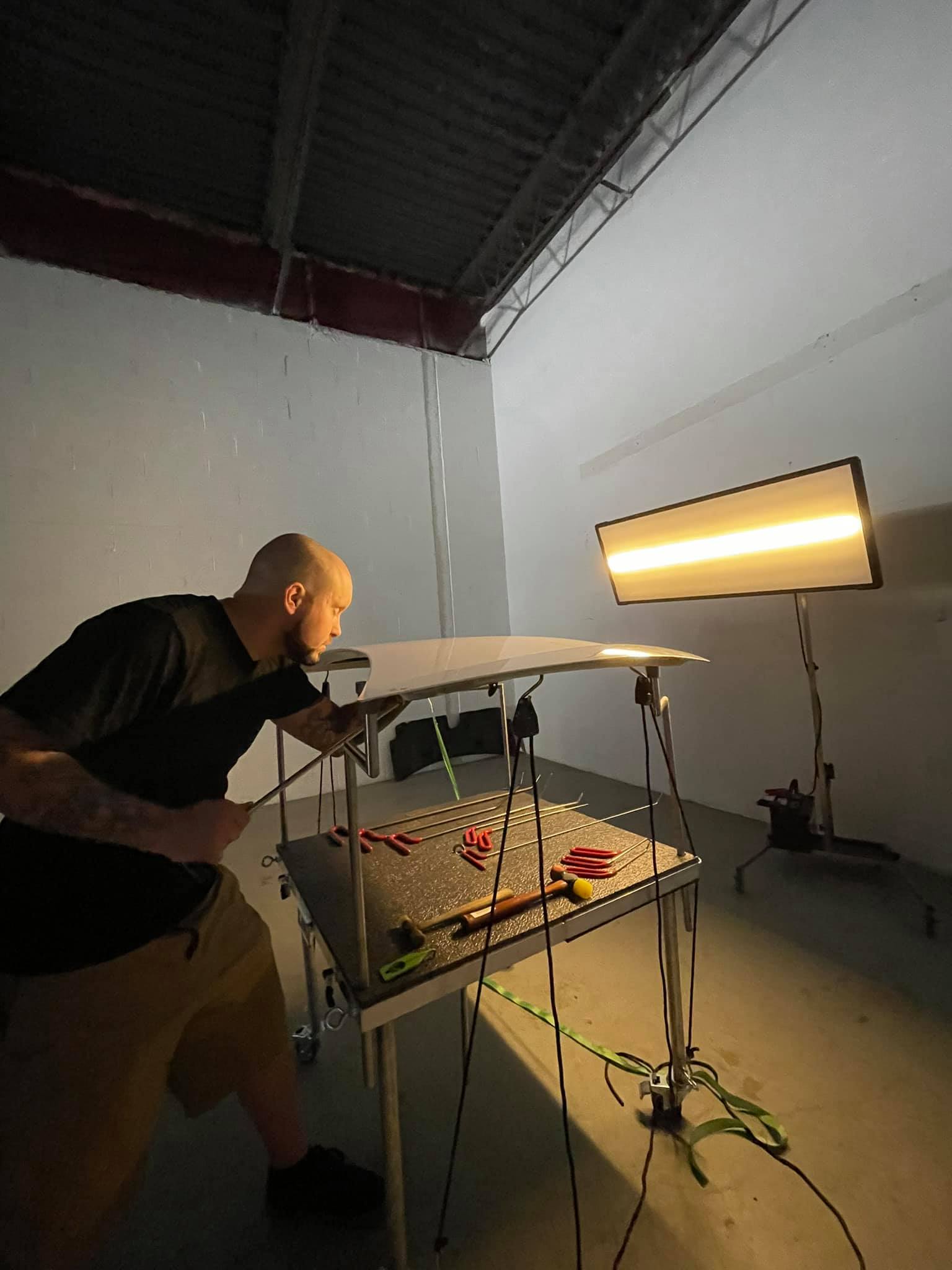The Science of Paintless Dent Removal
Paintless Dent Repair Science
REFLECTION:
Paintless Dent Repair (PDR) is a technique used to repair or remove dents and imperfections from the metal surface of a vehicle without the need for traditional bodywork and painting. One of the key tools used by PDR technicians is the reflection of light, which aids in identifying and manipulating the dent.
The science behind using light reflection in PDR involves understanding the principles of optics and how light behaves when it interacts with different surfaces. When light strikes a smooth, polished metal surface, it follows the laws of reflection. These laws state that the angle of incidence (the angle at which light hits the surface) is equal to the angle of reflection (the angle at which light bounces off the surface). This phenomenon allows PDR technicians to utilize light reflection to assess and repair dents. Here's a step-by-step explanation of how PDR technicians use light reflection in their process:
Assessing the dent: The first step is to evaluate the extent and location of the dent. The technician inspects the surface by examining it under different lighting conditions to identify the precise contours of the dent. They look for subtle shadows and irregularities caused by the deformation of the metal.

Light source selection: PDR technicians use various light sources to create reflections that help them visualize the dent more clearly. Commonly used light sources include handheld LED lights, fluorescent lights, or specialized reflection boards. These light sources provide consistent and uniform illumination for accurate assessment.
- Positioning the light source: The technician positions the light source in a way that creates a reflection on the metal surface. By carefully adjusting the angle and position of the light, they can enhance the visibility of the dent and its surrounding area. This reflection serves as a guide, revealing the depth, shape, and size of the dent.
- Reading the reflection: As the light reflects off the metal surface, the technician examines the reflection closely. They observe how the light interacts with the contours of the dent and the surrounding undamaged areas. The reflection will appear distorted or disrupted over the damaged region, allowing them to determine the precise location and shape of the dent.
- Manipulating the dent: Once the dent is thoroughly assessed using the reflection, the technician uses specialized tools to manipulate the metal from behind. By applying pressure at specific points, they gradually push the dent back into its original shape. The reflection is continually monitored during this process to ensure that the dent is being properly addressed.

4. Verifying the repair: After manipulating the dent, the technician reevaluates the repaired area using light reflection. They compare the reflection before and after the repair to ensure that the dent has been successfully removed or minimized. Any remaining imperfections can be further adjusted and corrected using the same technique.
In summary, the science behind using light reflection in PDR lies in the principles of optics. By capitalizing on the laws of reflection, PDR technicians can assess dents, manipulate the metal, and verify the repair by analyzing the way light interacts with the metal surface. This process enables them to restore the appearance of the vehicle's body without the need for extensive bodywork and painting.
Pushing Pattern:
When performing Paintless Dent Repair (PDR), technicians often use a pushing pattern from the backside of the metal surface to effectively remove dents and imperfections. This technique involves understanding the properties of the metal and the principles of force distribution to manipulate the damaged area without causing further harm to the panel. Here's a detailed explanation of the science behind the pushing pattern in PDR:
- Understanding metal behavior: To comprehend the pushing pattern technique, it's crucial to understand how metal responds to external forces. Metals, such as steel or aluminum, possess certain properties like elasticity and plasticity. Elasticity allows the metal to return to its original shape after deformation, while plasticity refers to the permanent deformation the metal can undergo. PDR technicians leverage these properties to manipulate the metal through controlled force application.
- Gaining access to the backside: Before initiating the pushing pattern, technicians gain access to the backside of the damaged panel. They may use various methods, such as removing interior panels or utilizing specialized tools with long, narrow tips that can reach behind the metal surface. This access allows them to apply force precisely at the location of the dent.

3. Selecting the pushing tool: PDR technicians use an array of tools specifically designed for manipulating metal from the backside. These tools are made of materials like stainless steel, which provides the necessary strength and flexibility. The tool selection depends on factors such as the size, shape, and location of the dent. Common tools used in PDR include rods, picks, and whale tails, each with different shapes and curves to match specific dent patterns.
4. Determining the pushing pattern: The pushing pattern is a strategic approach employed by PDR technicians to apply force on the backside of the dent. It involves identifying specific pressure points and gradually manipulating the metal in a systematic manner. The pattern is determined based on factors such as dent size, depth, and location. Technicians assess the reflection of light or use other visual cues to guide their choice of pressure points.
5. Distributing force: When applying force, PDR technicians employ the concept of force distribution. Instead of concentrating force at a single point, they disperse it across a broader area to minimize the risk of creating additional deformations or creases. By distributing force, they can gradually coax the metal back into its original shape.
6. Gradual and controlled pressure: PDR technicians apply gradual and controlled pressure while using the pushing pattern technique. The force is carefully adjusted based on the feedback received from the metal and the reflection of light. Technicians rely on their expertise to gauge the appropriate amount of pressure needed for each specific dent. They continuously monitor the reflection and make precise adjustments to ensure the metal is responding appropriately.

7. Assessing progress: Throughout the pushing pattern process, technicians regularly inspect the front side of the panel to evaluate the dent's progress. They may use light reflection, measuring devices, or their trained eye to determine the changes in the dent's appearance. If necessary, they adjust the pushing pattern or switch to alternative tools to achieve the desired results.
By utilizing the pushing pattern technique, PDR technicians can gradually manipulate the metal from behind the damaged panel. They take advantage of the metal's elasticity and plasticity properties, carefully distribute force, and apply controlled pressure to restore the original shape of the panel. This method minimizes the risk of additional damage and allows for precise dent removal without the need for conventional bodywork and painting.
Access - Leverage - Line Of Site
Access, leverage, and line of sight are three fundamental principles that play a crucial role in the science behind Paintless Dent Removal (PDR). These principles work together to enable technicians to effectively remove dents and imperfections from a vehicle's metal surface. Here's a breakdown of how these principles intertwine in the PDR process:
- Access: Access refers to the ability of the technician to reach the backside of the damaged panel. Access is essential in PDR because it allows technicians to apply pressure and manipulate the metal from behind. Creating access points is often the first step in the PDR process. Technicians may remove interior panels, use specialized tools with long, narrow tips, or even gain access through existing openings or gaps in the vehicle's structure.
Access is crucial because it enables technicians to directly apply force to the specific area of the dent, ensuring precise control over the repair process. Without proper access, it would be challenging to reach the backside of the panel and exert force in the necessary locations, limiting the effectiveness of the dent removal.

2. Leverage: Leverage refers to the mechanical advantage gained by using a tool or applying force in a specific way to achieve optimal results. In PDR, technicians utilize various tools designed for leverage, such as rods, picks, or whale tails. These tools allow them to exert force on the backside of the dent with precision.
The shape, length, and angle of the tool are crucial for creating the desired leverage. Technicians strategically position the tool against the metal, ensuring that the applied force is distributed evenly and in the correct direction. By manipulating the leverage, technicians can exert controlled pressure to gradually restore the metal to its original shape. Leverage amplifies the force applied, making it easier to push the dent out from the inside.
3. Line of sight: Line of sight refers to the visibility and clear view the technician has of the dent and the surrounding area during the repair process. Maintaining a proper line of sight is essential for precise dent removal. Technicians need to observe and assess the dent's shape, contours, and depth accurately.

To ensure an unobstructed line of sight, technicians often use light reflection techniques, specialized lighting, or reflection boards. These tools help them visualize the dent's details, shadows, and irregularities, aiding in the decision-making process for applying pressure and manipulating the metal. A clear line of sight enables technicians to monitor the progress of the repair and make necessary adjustments to achieve the desired results.
In summary, access, leverage, and line of sight are interconnected principles in PDR that facilitate the removal of dents and imperfections from a vehicle's metal surface. Access allows technicians to reach the backside of the panel, leverage helps them apply controlled force using specialized tools, and line of sight ensures clear visibility for accurate dent assessment and repair. By employing these principles effectively, PDR technicians can restore the vehicle's metal surface without the need for conventional bodywork and painting.
Comments ()